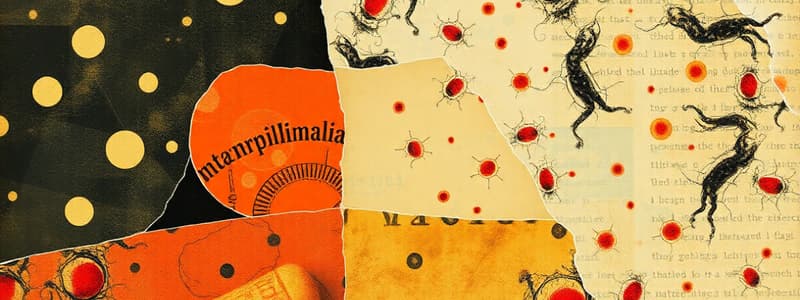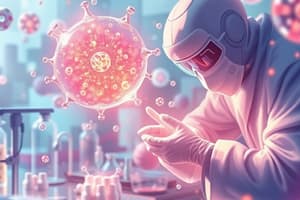Podcast
Questions and Answers
Which type of transport does not require energy from the cell?
Which type of transport does not require energy from the cell?
- Osmosis (correct)
- Facilitated Diffusion (correct)
- Endocytosis
- Protein Pumps
What is the primary focus of Lecture 6?
What is the primary focus of Lecture 6?
- Cell Culture Media
- Growing Mammalian Cells
- Nutrient Uptake (correct)
- Contamination Control
What is NOT a mechanism of active transport?
What is NOT a mechanism of active transport?
- Facilitated Diffusion (correct)
- Protein Pumps
- Endocytosis
- Osmosis (correct)
In which week is the recap of Lectures 2 through 5 scheduled?
In which week is the recap of Lectures 2 through 5 scheduled?
Which lecture covers the biology of culture cells?
Which lecture covers the biology of culture cells?
What is the primary function of a carrier protein in facilitated diffusion?
What is the primary function of a carrier protein in facilitated diffusion?
What essential knowledge is necessary before manipulating cells for product production?
What essential knowledge is necessary before manipulating cells for product production?
Which statement correctly describes channel proteins?
Which statement correctly describes channel proteins?
What type of immune response is covered in Lecture 15?
What type of immune response is covered in Lecture 15?
What is the primary function of the transport protein mentioned?
What is the primary function of the transport protein mentioned?
What happens to the protein channel after sodium ions are released to the outside of the membrane?
What happens to the protein channel after sodium ions are released to the outside of the membrane?
Which process is an example of active transport?
Which process is an example of active transport?
What best defines active transport?
What best defines active transport?
What direction do solutes move during facilitated diffusion?
What direction do solutes move during facilitated diffusion?
Which type of transport is characterized by the movement against the concentration gradient?
Which type of transport is characterized by the movement against the concentration gradient?
Which of the following does NOT characterize passive transport?
Which of the following does NOT characterize passive transport?
What is the main purpose of endocytosis in a cell?
What is the main purpose of endocytosis in a cell?
Which of the following is NOT a type of endocytosis?
Which of the following is NOT a type of endocytosis?
What feature distinguishes channel proteins from carrier proteins?
What feature distinguishes channel proteins from carrier proteins?
During which process do white blood cells consume bacteria?
During which process do white blood cells consume bacteria?
In active transport, what must occur to move molecules against their concentration gradient?
In active transport, what must occur to move molecules against their concentration gradient?
What initiates the change in shape of the transport protein channel?
What initiates the change in shape of the transport protein channel?
Regarding facilitated diffusion, which statement is incorrect?
Regarding facilitated diffusion, which statement is incorrect?
Which statement regarding passive diffusion is true?
Which statement regarding passive diffusion is true?
What is the process called when specific receptors on the cell surface bind to macromolecules for internalization?
What is the process called when specific receptors on the cell surface bind to macromolecules for internalization?
What is the fate of the receptor after receptor-mediated endocytosis?
What is the fate of the receptor after receptor-mediated endocytosis?
Which of the following is NOT a type of transport mechanism for nutrients into the cell?
Which of the following is NOT a type of transport mechanism for nutrients into the cell?
What distinguishes active transport from passive transport?
What distinguishes active transport from passive transport?
What occurs during exocytosis?
What occurs during exocytosis?
Flashcards
Passive Transport
Passive Transport
Movement of molecules across the cell membrane without requiring the cell to expend energy.
Osmosis
Osmosis
Movement of water molecules across a semi-permeable membrane from an area of high water concentration to an area of low water concentration.
Facilitated Diffusion
Facilitated Diffusion
Movement of molecules across the cell membrane with the help of transport proteins, but without requiring the cell to expend energy.
Active Transport
Active Transport
Signup and view all the flashcards
Protein Pumps
Protein Pumps
Signup and view all the flashcards
Endocytosis
Endocytosis
Signup and view all the flashcards
Exocytosis
Exocytosis
Signup and view all the flashcards
Carrier Protein
Carrier Protein
Signup and view all the flashcards
Channel Protein
Channel Protein
Signup and view all the flashcards
Sodium-Potassium Pump
Sodium-Potassium Pump
Signup and view all the flashcards
Vesicle
Vesicle
Signup and view all the flashcards
Transport Protein
Transport Protein
Signup and view all the flashcards
What is Receptor-mediated Endocytosis?
What is Receptor-mediated Endocytosis?
Signup and view all the flashcards
How does Receptor-mediated Endocytosis work?
How does Receptor-mediated Endocytosis work?
Signup and view all the flashcards
What is Exocytosis?
What is Exocytosis?
Signup and view all the flashcards
What are some examples of substances released through exocytosis?
What are some examples of substances released through exocytosis?
Signup and view all the flashcards
How are nutrients transported across the cell membrane?
How are nutrients transported across the cell membrane?
Signup and view all the flashcards
Study Notes
Week 1-12 Lecture Schedule
- Week 1 (Tue 10th Sept): Introduction to lecture modules
- Week 2 (Mon 16th Sept): Use of mammalian cells, Lab layout and Equipment, Cell culture materials
- Week 3 (Mon 23rd Sept): Contamination control
- Week 4 (Mon 30th Sept): Recap of lectures 2, 3, and 4, assessment questions
- Week 5 (Mon 07th Oct): Nutrient uptake
- Week 6 (Mon 14th Oct): Biology of Culture Cells
- Week 7 (Mon 21st Oct): Cell culture media, lab data analysis
- Week 8 (Mon 04th Nov): Cell Culture Media, recap lectures 8-11 and assessment questions
- Week 9 (Mon 11th Nov): Growing mammalian cells
- Week 10 (Mon 18th Nov): Monitoring cell growth, cryopreservation cells; recap of lectures 12-14 and assessment question
- Week 11 (Mon 25th Nov): Innate immune response, adaptive immune response and Bioassays
- Week 12 (Mon 02nd Dec): Recap of lectures 15-16, assessment questions, Revision (Tue 03rd Dec)
Lecture 7: Nutrients - Membrane Transport
- Lecture Overview (Slide 2): Introduction, nutrient uptake mechanism, conclusion
- Introduction (Slide 3): Cell manipulation for desired products and services requires understanding nutritional requirements.
- Passive Transport (Slide 4): Cell doesn't use energy (Diffusion, Osmosis, Facilitated Diffusion)
- Active Transport (Slide 4): Cell uses energy (Protein Pumps, Endocytosis, Exocytosis)
- Facilitated Diffusion (Slide 5): Transport of molecules down concentration gradient, facilitated by transport proteins (No energy input)
- Facilitated Diffusion - Carrier Protein (Slide 6): Protein alternates conformations, moves solute across membrane, direction down concentration gradient
- Facilitated Diffusion - Channel Protein (Slide 7): Aqueous channel, hydrophilic pore, rapid selective solute movement (size/charge).
- Active Transport (Slide 8): Movement against concentration gradient, requires metabolic energy and transport proteins
- Sodium-Potassium Pump (Slide 9): Specific receptors for sodium ions, phosphate group from ATP, shape change, release to outside, potassium ions bind, phosphate release, original shape, and potassium release back into the cell
- Passive vs. Facilitated vs. Active Transport Comparison (Slide 10): Characteristics comparison (carrier proteins, transport speed, against concentration gradient, specificity for molecules)
- Endocytosis and Exocytosis (Slide 11): Mechanism for large molecules, food, and waste into/out of cell. Endocytosis brings materials into the cell. Exocytosis moves materials out of the cell.
- Endocytosis Details (Slide 12): Process to move substances into the cell without crossing the membrane. Types include phagocytosis (large particles), pinocytosis (small particles), and receptor-mediated endocytosis
- Receptor-mediated Endocytosis (Slide 13): Specific receptor on the cell surface binds tightly to macromolecule, then undergoes endocytosis (receptor recycling) examples include cholesterol, transferrin, and insulin.
- Exocytosis (Slide 14): Bulk material removal from the cell. Cell changes shape - requires energy. Examples include hormones and wastes
- Conclusion (Slide 15): Nutrients enter the cell via passive or active transport mechanisms. Passive transport doesn't require energy, and active transport always requires energy.
Studying That Suits You
Use AI to generate personalized quizzes and flashcards to suit your learning preferences.




